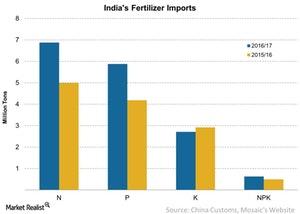India’s Fertilizer Imports and Why They Fell
For 2016, India’s imports of nitrogen fertilizers, which only included numbers for urea, fell 27.0% to 4.9 million metric tons.
July 10 2017, Updated 7:38 a.m. ET

India’s imports
In the previous part of this series, we saw that India consumed about one-fifth of the global fertilizer in 2014. Let’s look now at India’s fertilizer imports in 2016 and how they changed from a year ago.
Imports fell
For 2016, India’s imports of nitrogen fertilizers, which only included numbers for urea, fell 27.0% to 4.9 million metric tons, from 6.8 million metric tons in 2015.
Phosphate imports fell 29.0% year-over-year in 2016 to 4.2 million metric tons, from 5.9 million metric tons a year ago in 2015. These phosphatic fertilizer import numbers include only DAP (diammonium phosphate) fertilizers.
NPK (nitrogen, phosphorous, potassium) blended fertilizer imports also saw a negative trend in 2016. They fell 22.0% year-over-year to 0.50 million metric tons in 2016, from 0.60 million metric tons in 2015.
Potash rose
India delayed its contract settlement for potash fertilizers as it waited for potash prices to bottom out. However, with contract settlements taking place late in the second half of the year, India’s potash imports rose 8.0% year-over-year to 2.9 million metric tons, from 2.7 million metric tons. Both China and India get their potash from companies (MOO) such as Israel Chemicals (ICL), PotashCorp (POT), Agrium (AGU), and Mosaic (MOS).
Following the breakup of Uralkali and Belaruskali, these companies have gained their presence as potash suppliers to China and India.
Next, we’ll take a look at Brazil’s fertilizer imports.
